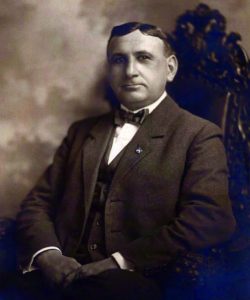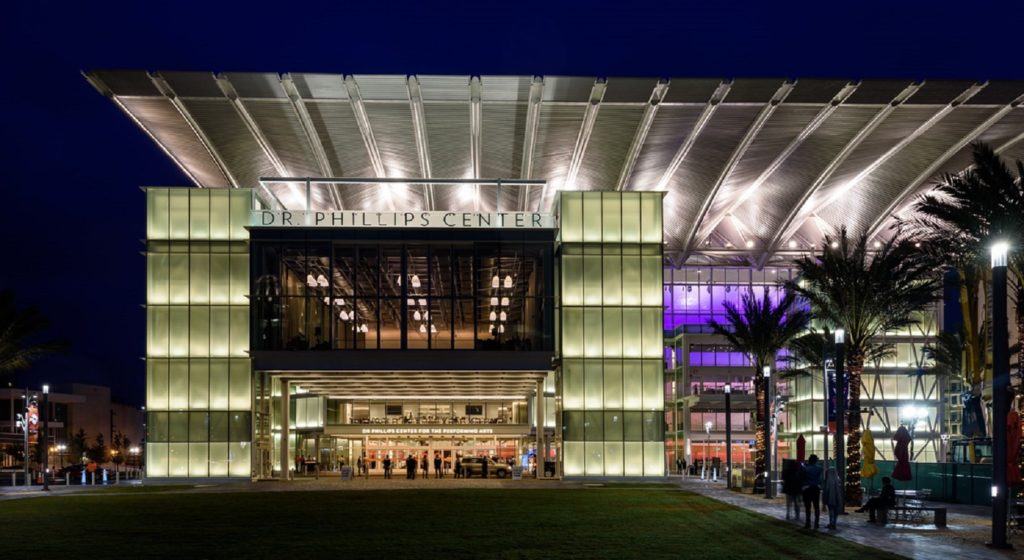Article by Kristin Eastlick for Capital Research
A Citrus Pioneer
 Summary:
Summary:
It’s a rare organization that can begin in humble origins, carve out an identity as a major economic and philanthropic presence, and, for more than sixty years, faithfully embody the entrepreneurship, industriousness, and compassion of its namesake. And yet that’s exactly what Central Florida’s Dr. Phillips Charities has been able to do. This installment of the Doing Good series shows just a small portion of the impact one family’s legacy has made on a community for generations.
Who Was Doc Phillips?
In the 1800s, citrus trees grew wild throughout Florida’s dense forests. In the middle part of the century, early entrepreneurs began to turn the fruit into a profitable business, following the success of some early grove farming in Central Florida. By 1893, the state’s annual citrus production had grown to more than five million boxes, according to Florida Citrus Mutual, a citrus industry trade group.
It was into this burgeoning industry that Dr. Philip Phillips arrived in 1894. At just 20 years old, Phillips, a native of Memphis, Tennessee, had recently received his medical degree from Columbia University. (While little is known about what brought the young man to New York City for his education, he valued learning the rest of his life.)
Yet barely a year after Dr. Phillips (who came to be known as “Doc”) purchased his first orange grove in Satsuma (roughly 90 miles north of Orlando), the region was hit by one of the most devastating freezes in Florida’s history. After two days of below-freezing temperatures destroyed his citrus trees, Phillips returned to his hometown for more than seven years. But he didn’t stay away for long; he regularly returned to Florida and purchased small parcels of land, mostly located in Central Florida’s Osceola County. Finally, in 1902, accompanied by his wife, Della, and his newborn son, Howard (a second son, Walter, was born in 1904), the Phillips settled in Orlando—a move that launched a major citrus empire. Dr. Phillips Inc. would ultimately span multiple counties, including more than 5,000 acres of citrus groves and two packing houses.
A Pioneer in Florida’s Citrus Industry
By 1915, Florida’s citrus industry had rebounded, with annual production in the industry reaching 10 million boxes. Dr. Phillips empire continued growing. At one point, according to a June 2017 Orlando Sentinel article by Joy Wallace Dickinson, Doc’s enterprises sold 100,000,000 oranges from his groves per year. But perhaps more importantly, he helped transform the processing of orange juice that helped drive consumption. Since refrigeration wasn’t common in the 1920s and 30s, the industry had to solve the problem of preserving juice so it could be easily transported and stored. After buying his own processing plant, Doc created and patented “flash” pasteurization, a process that helped eliminate the metallic taste that plagued earlier canning processes. “[B]y 1931,” writes Dickinson, “the Phillips cannery [was] able to produce 24,000 cans of juice every day.”
Doc also excelled at marketing the industry. As described in the biography from his induction into the Florida Citrus Hall of Fame, Doc was the first to sell oranges by the pound, which proved persuasive in live demonstrations showing how much juice could be produced by 10 pounds of fruit. (He even enlisted the help of his college-aged son Howard to showcase their fruit offerings across the Midwest.) Given his medical background and armed with new research showing high levels of vitamin C was present in canned citrus products, the company’s canned products soon carried the label: “Drink Dr. Phillips’ orange juice because the Doc says it’s good for you.” Indeed, Dickinson reports that the American Medical Association’s Council on Foods issued its seal of acceptance on Dr. Phillips’ canned products in the early 1930s. (Many believe these early marketing successes paved a way for later growth in the juice industry, particularly the success of frozen concentrate, by increasing consumer awareness of orange juice and making it synonymous with health.)
The company even took advantage of early cinema technology, including working with the new Technicolor film process, to develop promotional films to expose more consumers to citrus products and the industry.
An Unusual Response to the Agricultural Cycle
While Doc was building his successful enterprise, he quickly learned of the challenging cyclic nature of citrus agriculture practices. Part of the year was incredibly taxing: planting, harvesting, and processing. As the business was growing, Doc even recruited temporary help from as far as the Bahamas. But the remaining part of the year slowed down incredibly, and work dried up. Valuable employees who contributed during the times of heavy production were laid off, and Doc soon realized that he was losing talented employees because of those predictable labor swings.
In the early 1920s, Doc discovered the solution in real estate development. In his years of owning farming acreage, he found that some of his land would not grow citrus, so he soon had the company begin construction of commercial and industrial buildings on those sites. On new properties, the firm added buildings that helped support the various functions of the citrus industry. Rather than hire a new fleet of employees for these ventures, Doc’s construction projects provided employment opportunities for his agricultural workforce during the slow seasons, and the company benefited from the additional income generated by renting out the finished builds.
In addition to stabilizing the work cycle for his employees, Doc provided other amenities for his labor force. He established nearby housing and began building a full-fledged community, including a post office to provide additional services to workers and their families. One of the first of the new construction projects to be built was the Dr. Phillips Theater in what is now downtown Orlando on the corner of Orange and Pine Street. The building still exists today and houses City Arts Factory. Dr. Phillips was the first citrus grower to dust his groves using airplanes. The air strip he used to land his crop dusters is now a gated community called Phillips Landing.
Doc Phillips built a full-fledged community to provide additional services to workers and their families.
For fifty years, Doc and his family built one of the most successful citrus enterprises in the industry. Finally, in 1954—60 years after he first arrived in Florida with a $5,000 endowment from his father—Doc and his family sold the citrus business to Granada Groves, a partnership between Investors Diversified Services and Minute Maid.
From Orchards to the City
 The sale of the citrus portion of his enterprises moved Doc and the rest of Dr. Phillips, Inc. into the second phase of the company’s history. The firm began to focus its primary business efforts on the building and leasing of commercial and industrial buildings. Blocks of Orlando real estate development can point to Dr. Phillips for their origin. For example, the firm created the first Industrial Park just north of Orlando that featured a Sears Roebuck distribution warehouse, among other leases. At one time, Dr. Phillips, Inc. owned and leased more than two and a half million square feet of buildings in the Central Florida area with more than 300 tenants. The litany of major current or past tenants are renown: Howard Johnsons, Sears Roebuck, Crown Cork and Seal, Nabisco, B.F. Goodrich, Goodyear, Publix, Winn-Dixie, Porter Paint, Amoco, Sealtest, Hertz Rent-a-Car, Armour Foods, Goulds Pumps, Bell South, Dupont Paint, and Stanley Home Products, among others.
The sale of the citrus portion of his enterprises moved Doc and the rest of Dr. Phillips, Inc. into the second phase of the company’s history. The firm began to focus its primary business efforts on the building and leasing of commercial and industrial buildings. Blocks of Orlando real estate development can point to Dr. Phillips for their origin. For example, the firm created the first Industrial Park just north of Orlando that featured a Sears Roebuck distribution warehouse, among other leases. At one time, Dr. Phillips, Inc. owned and leased more than two and a half million square feet of buildings in the Central Florida area with more than 300 tenants. The litany of major current or past tenants are renown: Howard Johnsons, Sears Roebuck, Crown Cork and Seal, Nabisco, B.F. Goodrich, Goodyear, Publix, Winn-Dixie, Porter Paint, Amoco, Sealtest, Hertz Rent-a-Car, Armour Foods, Goulds Pumps, Bell South, Dupont Paint, and Stanley Home Products, among others.
Today, Dr. Phillips, Inc. continues to maintain many properties as a part of its investment portfolio; it remains one of the largest commercial landlords in Central Florida. The firm’s decision to invest in real estate was both good for the company and ultimately good for the community.
Philanthropy Begins at Home
Many of Doc’s business decisions arose out of a charitable and giving spirit that he demonstrated throughout his life. While running his orchards, Doc paid keen attention to the needs of his workforce. The creation of his Dr. Phillips housing community for his employees and families was only one element; as described in the Florida Citrus Hall of Fame, he “always made sure his workforce was taken care of in every way.”
His focus on public welfare was often ahead of its time. In the 1950s, recognizing that proper health care for African-American citizens of Central Florida was almost non-existent, Doc helped to establish the Dr. Phillips Memorial Hospital. Howard (who had ultimately finished his education at Harvard) was also dedicated to this project and encouraged two African-American doctors to relocate to Orlando to establish their practice.
The Phillips family’s generosity and keen passion for helping people in the community led to the establishment of The Dr. P. Phillips Foundation in 1953 to support charitable needs in the Central Florida area. Dr. Phillips, Inc. is now also a non-profit organization, and the two organizations together compose Dr. Phillips Charities.
Doc also valued the importance of education and teaching the values of American free enterprise to the young people in his community. He was integral in bringing a Junior Achievement chapter to Central Florida, and was committed to funding that effort; since its inception, Dr. Phillips Charities have contributed over $2 million to ensure Junior Achievers have the background in entrepreneurship, financial literacy, and work readiness required to pursue their futures.
Unlike some entrepreneurs of the time, Doc built up his foundation while he was still alive, and he was able to be involved with the organization for six years before he died. The family felt that it was important to support programs that would correct the origins or causes of a problem, thus leading to the Foundation’s motto “helping others help themselves.” Howard, who focused his time on managing the foundation after the sale to Granada, continued the family legacy of philanthropy after Doc’s death in 1959 (and, in 1968, Della’s death).
The family felt that it was important to support programs that would correct the origins or causes of a problem, thus leading to the Foundation’s motto “helping others help themselves.”
The Legacy of Doc Phillips and His Family
Today, there are many community buildings named to honor the Phillips Family in Central Florida, including the Dr. P. Phillips Hospital, a hospital built on a parcel of land Doc purchased in 1905. Dr. Phillips Charities has awarded nearly $200 million in grants, pledges, and program-related investments to Central Florida charities responding to the needs of the community and directly touching the lives of thousands of children and families each year. The support has focused on five primary service areas, including:
- Educational programs,
- Children and Youth Services,
- Social Services,
- Cultural Programs, and
- Health or rehabilitative programs.
The Charities also support nonprofit organizations that seek to preserve the free enterprise system and protect private property rights. [Editor’s note: Since 1988, Capital Research Center has received annual contributions from The Dr. P. Phillips Foundation.]
While Dr. Phillips Charities touch countless individuals in the Central Florida area, an examination of two organizations can showcase the spectrum of their impact—from the way Orange County Public Schools (OCPS) change individual students’ lives and LIFT Orlando transforming an entire community.
Achieving Student Success
Throughout his life, Doc Phillips was committed to education, and his foundation has maintained that focus throughout its lifespan. When challenged by the well-known skills gap facing the Central Florida workforce, Dr. Phillips Charities decided to partner with OCPS Career & Technical Education. The program they developed—the Dr. Phillips Charities Certified Schools Grant Program—helps change students’ lives through innovative, hands-on educational programs. By encouraging high-school-age students to complete career and technical training programs, students have opportunities to earn industry certifications and licensure in essential fields like agriculture, information technology, engineering, and more.
The OCPS career training programs funded through grants from Dr. Phillips Charities help students benefit from the “best of both worlds” when it comes to their studies. Through technical college dual enrollment, students can take their core academic classes at their home high school, and take Career & Technical Education (CTE) courses in their chosen career field at one of five technical college campuses—or in many cases, right on their home high school campus. Students can leave high school prepared for both career and college through industry-based training programs like those that the Dr. Phillips Charities program helped create.
One such student was Anthony Thomas, who decided to enroll in the program because he wanted a better job when leaving high school. Through the program, he was able to intern at East Orlando Florida Hospital, an opportunity which first led to a volunteer position and then full-time employment at the pharmacy at Winter Park Memorial Hospital. According to Anthony, “If I didn’t do the program at the tech center, I wouldn’t have gotten the job. The training and the tests fully prepare students to be over-ready to pass the certification test.”
Dr. Michael Armbruster, Associate Superintendent of CTE, has been particularly proud of the accomplishments of students coming out of the programs at all levels. “We have incredible, passionate students who share their skills at state competitions, industry functions, trade shows or simply in the classroom every day. What makes me so proud is that we in CTE, have somehow shaped their career journey, and have given them the confidence to succeed in life, no matter where that road may take them.”
What makes me so proud is that we in CTE, have somehow shaped their career journey, and have given them the confidence to succeed in life, no matter where that road may take them.
What’s particularly unique about this program is the interaction between the program and Dr. Phillips Charities. Dr. Phillips Charities Board of Directors have helped CTE acquire the technology and equipment that meets industry standards and prepares students for the industry certifications they need. But Dr. Phillips Charities avoids a common pitfall in grant making; according to the CTE administrators, they don’t micromanage the grants. While the charity leaders are clear on what they want to see from the grant programs, the Board at Dr. Phillips allow CTE professionals the autonomy to act in making those initiatives happen.
“Dr. Phillips Charities makes it clear what they would like to see from the grant program,” says Dr. Armbruster, “but have trusted us with a collaborative process in making those plans come to life.”
Like the inspired real estate development spearheaded by the organization’s namesake, Dr. Phillips Charities Certified Schools grants have helped create new learning spaces like the greenhouse at Dr. Phillips High School, established new programs like Building Construction at East River High School, and provided essential tools to many programs across the school district.
Through its innovative grant making, Dr. Phillips Charities has worked with OCPS to bring together the involvement of students, families, and instructors with educational programs. This model is embraced and enhanced by the imaginative and functional learning happening in these classrooms.
The Power of Collaboration
 Another program that illustrates the Doc Phillips legacy also begins with real estate.
Another program that illustrates the Doc Phillips legacy also begins with real estate.
In 2012, Tom Sittema, CEO of CNL Financial Group, gathered a group of community-minded business leaders to pursue the question: “How can the business community help solve some of our city’s most complex social problems?” After much research, they became inspired by the opportunity to leverage their influence and align their social responsibility efforts in partnership with Florida Citrus Sports (FCS) as the firm worked to redevelop the aging Camping World Stadium (formerly known as the Citrus Bowl). LIFT Orlando was founded to leverage the stadium’s reconstruction and ignite positive neighborhood transformation for its neighboring families.
This ambitious project challenges the paradox of “toxic charity,” as described by author and urban activist Bob Lupton. In 2009, the three-year research project, “Seeking the Welfare of the City,” identified an impressive 3,800+ registered non-profits and charities in Central Florida. However, it also found that the area had consistently been ranked among the worst out of the 200 U.S. cities evaluated annually by the Gallup Well-Being Index. In spite of a great culture of service in Central Florida, most charitable organizations had failed to realize that relief and betterment programs alone have never proven to strengthen families for the long term.
Most charitable organizations have failed to realize that relief and betterment programs alone have never proven to strengthen families for the long term. LIFT Orlando has opted for a different approach.
Armed with that research, LIFT Orlando opted for a different approach. The organization harnesses the powers of entrepreneurship, charitable giving, and smart city planning. It consists of business leaders partnering with residents to break the cycle of poverty through neighborhood revitalization, including mixed-income housing, cradle-to-career education, community health and wellness, and long-term economic viability. But this innovative initiative would not have been launched without Dr. Phillips Charities.
Ken Robinson, President and CEO of Dr. Phillips Charities, first learned about LIFT Orlando while on the board of Florida Citrus Sports. As LIFT Orlando’s executive director, Eddy Moratin, describes, “[Ken heard] about what we were envisioning for these inner-city neighborhoods and immediately offered to help. He asked us how we were going to manage to transform what was then the worst apartment community in Orlando in the lowest income neighborhoods in town.”
In 2013, Fannie Mae foreclosed on a major apartment complex near the stadium, displacing roughly 1,200 residents. The agency then wouldn’t sell the structures to LIFT Orlando, instead selling them to the City of Orlando. Through a program-related investment of $4 million dollars from The Dr. P. Phillips Foundation, LIFT Orlando was able to purchase then demolish the buildings and start the rebuilding process. “[I]t was the bold [investment] to a new and untested nonprofit that provided the greatest example of The Dr. P. Phillips Foundation leadership in our story,” explains Moratin.
Dr. Phillips program managers have again followed a results-oriented approach to grantmaking. “They have been much more interested in outcomes than process,” says Moratin. “They knew the [Orlando] area well because of Ken’s involvement on the FCS Board, so it was clear that LIFT Orlando’s holistic vision…was the kind of bold intervention needed. Their expertise in real estate development and property management helped them see the possibilities.”

The Dr. Phillips Center for the Performing Arts is a wonderful example of philanthropy, business, and the community coming together. The vibrant cultural community gathering place in downtown Orlando continues Doc and Della’s legacy and proudly bears his name for all of Central Florida and the world to enjoy. Photo courtesy of Dr. Phillips Center for the Performing Arts.
LIFT Orlando also brings out the best through collaboration among business leaders, community leaders, and government agencies. Among their major milestones, the group has raised $40 million to build 200 units of new, mixed income housing; initiated Job Support Services including recruiting local employers with the goal of 100 percent employment in the neighborhood; secured an annual gift of a $100,000 matching grant from the College Football Playoffs Foundation for teacher development, recognition, and supplies; and received a grant of $400,000 from JP Morgan Chase to offer microloans to businesses in the development area.
The latest research supports the boldness of The Dr. P. Phillips Foundation in funding LIFT Orlando’s projects. “An overwhelming amount of research, in fact, asserts that…truly breaking the cycle of generational, concentrated poverty requires a holistic approach with a bold geographic focus,” explains Moratin. “A recent study by the Federal Reserve affirmed the importance these place-based initiatives [like LIFT Orlando] for their vital role in connecting economic growth to economic opportunity in disenfranchised neighborhoods.” In this way, LIFT Orlando embodies the foundation’s goal “to help others help themselves.”
It’s been more than 100 years since the Phillips family began transforming Central Florida through a combination of entrepreneurship and compassion. LIFT Orlando continues that tradition of meaningful change.
The Dr. Phillips Center for the Performing Arts
Dr. Philip Phillips and his wife, Della, were great supporters of the performing arts. To date, Dr. Phillips Charities pledged $37,288,500 million in contributions to The Dr. Phillips Center for the Performing Arts, a world class performing arts center in Downtown Orlando, Florida. This beautiful $500,000,000 venue is a wonderful example of philanthropy, business, and the community coming together.
The vision for this vibrant cultural community gathering place reflects the past vision of the Phillips family and todays board to build a dynamic downtown Orlando. The Dr. Phillips Center showcases Arts for Every Life and further reflects the vision that Doc and Della endowed the city with, a combined passion for community and a love of the arts.
While the Phillips family is primarily known for innovations in the growing, processing, and packaging of citrus, contributions to the performing arts that began in their home on Lake Lucerne, just blocks away, continue to shape the arts community of Central Florida. The Dr. Phillips Center for the Performing Arts represents Dr. Philip Phillips’ legacy in more ways than just his love of the arts. He cared for the people who worked for him, the Central Florida community, and lived up to his legacy “Helping Others Help Themselves.” The Dr. Phillips Center for the Performing Arts is a continuation of the legacy which proudly bears his name for all of Central Florida and the world to enjoy.
Majority of Giving Focused Locally for Greater Impact
A vast majority of Dr. Phillips Charities giving is focused in Orange and Osceola counties. They are able to have the most impact by focusing their efforts locally. The structure of the organization is such that they intend to continue to grow and gift more each year.
Howard Phillips passed away in 1979. At that time, Dr. Phillips Charities was roughly $80 million. Today, 38 years later, they have grown more than three times that amount while gifting nearly $200 million.
Conclusion
When Dr. Philip Phillips passed away on April 18, 1959, the family ensured his marble tombstone read “Under His Hand the Wilderness Bore Fruit.” But Doc’s legacy extends far beyond the forests of his early orange groves. His wealth has enriched the communities of Central Florida, and through the generosity he inspired in others, thousands of lives have been transformed.
